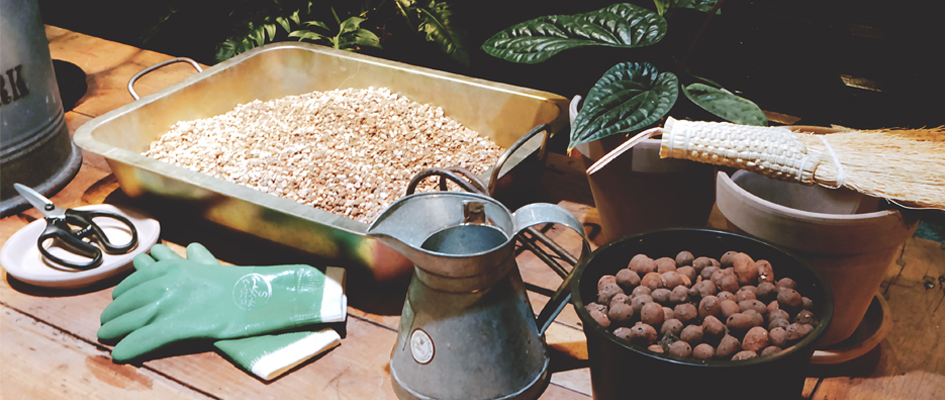As a green thumb, do you know how to repot plants? Repotting is crucial for plants; regularly changing their pots can promote lush growth and upgrade the overall quality of your plants. In our upcoming edition, we’ve invited a popular booth from Jianguo Flower Market – Arboriculture, to teach you how to correctly repot indoor plants and address common repotting queries. Let’s take a look together!

The Importance of Repotting for Plants
As time passes, plant roots continuously grow, gradually filling up the entire pot. Without regular repotting, the growth space for roots becomes limited, ultimately hindering the plant’s development. Additionally, the plant medium gradually loses nutrients and quality over time, and may even become a breeding ground for fungus gnats. Therefore, repotting is a must-learn plant cultivation technique for green thumbs!

Regularly changing the pot can promote denser plant growth.

Plant Repotting in 4 Steps
Tools Needed:
Plant to be repotted, new pot, shovel, rake, small broom, gardening shears, gloves, succulent soil, perlite, watering can.
💡 Tips: Depending on the plant’s characteristics, choose different media. For ordinary foliage plants, you can use a mixture of succulent soil and potting soil.

Step 1: Add Medium
Start by laying a layer of high-drainage perlite, then add succulent soil. Remember not to add too much soil initially; wait until the plant is transferred before adding more soil. The original soil does not need to be replaced, to avoid introducing bacteria into the new soil.
💡 Tips: Choose a new pot slightly larger than the original one to provide room for growth. Avoid selecting pots that are too large, as excessive medium may hinder absorption and lead to root rot.

The bottom layer consists of highly hydrophobic expanded clay pebbles.

Step 2: Removing the Plant from the Pot
Assist the roots in slowly removing the plant from the pot, then gently remove the original medium. Be careful not to damage the roots and take this opportunity to observe their condition. If you notice soft, black roots, it indicates root rot. Carefully trim starting from the root tips before proceeding with the repotting process.
💡Tips: It’s recommended not to water the plant before repotting. Keeping the medium dry will make it easier to remove the plant.

Step 3: Placing the Plant & Adding Medium
Place the plant into the new pot and add more succulent soil. Gently tap the pot to reduce any air gaps. Sometimes, you may need to add more soil until the pot is about 80% full to complete the repotting process.

Step 4: Watering the Plant
Immediately water the plant after repotting to ensure the plant and the medium are tightly bonded. This also helps to verify if there’s enough medium in the pot. Use a small broom to clean any soil from the pot. After repotting, place the plant in a well-ventilated area indoors. Wait for the soil to dry before watering again. It’s recommended to adjust the watering frequency based on the weather to avoid overwatering or underwatering the plant.
💡Tips: Regularly wipe the leaves of the plant to remove dust and keep them vibrant green. This also helps to inspect the plant for any pest issues, especially on the underside of leaves where pests may hide their eggs. Don’t forget about this step!


You can observe the underside of the plant leaves to check for any pest issues.
Q&A on Potting:
Q: How do I know when my plant needs repotting? Do I need to divide it?
A: It’s time to repot when the plant outgrows its container or if wilting occurs despite adequate care, which could indicate root rot. Division depends on the plant; not all plants are suitable for division.
Q: How can I tell if a potted plant bought from a flower market needs repotting?
A: Flower market plants often come in soil that’s too wet or sticky for Taipei’s weather and may harbor pest eggs. You can ask the seller if the plant needs repotting.
Q: Does the material of the pot affect the plant?
A: Material matters less than drainage holes at the bottom of the pot, which aid in water drainage.
Q: Is there a suitable season or time for repotting?
A: Any time is suitable except for very cold weather or midday heat.
Q: Is it better to mix my own potting medium or buy one?
A: Succulent soil is versatile. Mixing it with regular potting soil in appropriate proportions caters to various plants.
Q: With many pot colors available, how do I choose the right one for my plant?
A: For indoor plants, match the pot to your home decor rather than the plant. Nordic styles can go with simple cement pots, while country styles may suit colorful and cute pots.
With the thorough guidance from Shu Garden, even beginners can easily repot their plants, ensuring lush and healthy growth! Besides plant care tips, Shu Garden also offers a variety of beautiful plants. Why not explore the nearby Jianguo Flower Market this weekend and bring some of these plants home?

